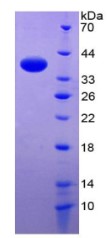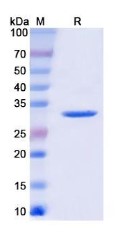PLN
-
Official Full Name
phospholamban -
Overview
The protein encoded by this gene is found as a pentamer and is a major substrate for the cAMP-dependent protein kinase in cardiac muscle. The encoded protein is an inhibitor of cardiac muscle sarcoplasmic reticulum Ca(2+)-ATPase in the unphosphorylated state, but inhibition is relieved upon phosphorylation of the protein. The subsequent activation of the Ca(2+) pump leads to enhanced muscle relaxation rates, thereby contributing to the inotropic response elicited in heart by beta-agonists. The encoded protein is a key regulator of cardiac diastolic function. Mutations in this gene are a cause of inherited human dilated cardiomyopathy with refractory congestive heart failure. -
Synonyms
PLN;phospholamban;PLB;cardiac phospholamban;CMD1P;CMH18;PPLA_HUMAN;OTTHUMP00000017092
Recombinant Proteins
- Human
- Mouse
- Rhesus macaque
- Rat
- Chicken
- Zebrafish
- E.coli
- Mammalian Cell
- Wheat Germ
- Yeast
- HEK293
- GST
- His
- His&GST
- Non
- His&Fc&Avi
Background
What is PLN?
Phospholamban (PLN) is an integral membrane protein that regulates the contraction and relaxation cycles of the heart muscle. Its importance lies in its ability to control cardiac activity, with alterations in its structure or function leading to severe cardiac diseases.
The Discovery of the PLN Protein
PLN was discovered in the mid-1970s by Prof. Larry R. Jones and his team to explain an unidentified protein found in cardiac tissue. The PLN protein was isolated, sequenced, and characterized, which marked a significant step towards understanding cardiac function and the roots of several cardiac diseases.
Gene Locus and Protein Structure
The PLN protein, also known as phospholamban, is encoded by the 'PLN' gene found specifically on chromosome 6q22.1. This protein is vital for cardiac muscle function. It is composed of 52 amino acids, enriched in the sarcoplasmic reticulum (SR) of cardiac and slow-twitch skeletal muscle cells. It acts as an inhibitor of the sarco/endoplasmic reticulum Ca2+-ATPase (SERCA2a) pump, controlling the calcium ion concentration within cells, consequently regulating muscle contraction and relaxation.
PLN protein encompasses a unique structural dichotomy: a highly hydrophilic cytoplasmic domain and a very hydrophobic domain embedded into the SR membrane. Its conformational flexibility enables dynamic interaction with SERCA2a, modulating its activity accordingly.
The Function of PLN Protein
The primary role of PLN is to regulate the SERCA2a pump, which moves calcium ions out of the cytosol and into the SR. By inhibiting SERCA2a, PLN lowers the rate of calcium ion re-uptake into the SR during relaxation of the heart muscle, thereby slowing the relaxation rate. However, when PLN is phosphorylated by protein kinases in response to beta-adrenergic signaling, it relieves its inhibition of SERCA2a, accelerating relaxation and priming the heart for the next contraction.
PLN Protein Associated Signaling Pathways
The principal pathway centers on the interaction between PLN and SERCA2a. Upon the cell's stimulation, cyclic adenosine monophosphate (cAMP)-dependent protein kinase A (PKA) gets activated, phosphorylating PLN at Ser16. Furthermore, calcium/calmodulin-dependent protein kinase II can also phosphorylate PLN at Thr17. Upon phosphorylation, the inhibitory effect of PLN on SERCA2a is diminished, raising the pump's calcium affinity and consequently augmenting the rate of muscle relaxation.
PLN Protein Related Diseases
Mutation or misregulation of the PLN gene is closely associated with various cardiac diseases. Pathogenic mutations result in dilated cardiomyopathy (DCM) and arrhythmogenic right ventricular cardiomyopathy (ARVC), where hearts become enlarged or inflamed and have difficulty pumping blood efficiently. Also, the PLN R14del mutation is linked to sudden cardiac deaths at a relatively young age.
PLN Protein's Applications
Due to the central role of PLN protein in modulating cardiac function, it has become a significant target for pharmacological research. Drugs designed to normalize the function of PLN could help treat heart diseases related to calcium ion dyshomeostasis. Also, gene therapies that target PLN expression or function could potentially be used to treat cardiac diseases related to PLN mutations.
Additionally, the use of PLN as a biomarker has been explored. Elevated PLN levels can indicate cardiac dysfunction, leading to studies measuring PLN in patients with heart failure to assess disease severity and progression.
In conclusion, the discovery of PLN protein has catalyzed critical advances in our understanding of heart function and related disorders. The detailed knowledge of the protein's structure, function, and related signaling pathways illuminated its critical role in cardiac muscle relaxation and contraction. With the association of PLN with various cardiac diseases, it offers a promising therapeutic target. Whether through drug development or gene therapies, the application of PLN will undoubtedly continue to yield vital insights into the prevention and treatment of severe cardiac diseases.
Case Study
Case 1: Vafiadaki E, et al. Int J Mol Sci. 2022.
Phospholamban (PLN), a key modulator of Ca2+-homeostasis, inhibits sarcoplasmic reticulum (SR) calcium-ATPase (SERCA2a) and regulates cardiac contractility. The human PLN mutation R14del has been identified in arrhythmogenic cardiomyopathy patients worldwide and is currently extensively investigated. In search of the molecular mechanis
ms mediating the pathological phenotype, researchers examined PLN-R14del associations to known PLN-interacting partners.
Their findings reveal for the first time that by increased binding to SERCA2a and HAX-1, PLN-R14del acts as an enhanced inhibitor of SERCA2a, causing a cascade of molecular events contributing to impaired Ca2+-homeostasis and arrhythmogenesis. Relieving SERCA2a super-inhibition could offer a promising therapeutic approach for PLN-R14del patients.

Fig1. Pulldown assays using PLN-WT or PLN-R14del recombinant proteins and mouse cardiac extracts determined enhanced PLN-R14del binding to SERCA2a, HAX-1, and HRC and reduced binding to GM.

Fig2. PLN-R14del exhibits altered interactions to known PLN-binding partners. Quantification of protein interactions detected by pull-down assays (n = 4; * p < 0.05 vs. PLN-WT; t test, two-tailed)
Case 2: Feyen DAM, et al. Circulation. 2021.
Phospholamban (PLN) is a critical regulator of calcium cycling and contractility in the heart. The loss of arginine at position 14 in PLN (R14del) is associated with dilated cardiomyopathy with a high prevalence of ventricular arrhythmias. How the R14 deletion causes dilated cardiomyopathy is poorly understood, and there are no disease-specific therapies.
The authors used both 2-dimensional and 3-dimensional functional contractility assays to evaluate the impact of modulating disease-relevant pathways in PLN R14del hiPSC-CMs.
Their findings suggest that the UPR exerts a protective effect in the setting of PLN R14del cardiomyopathy and that modulation of the UPR might be exploited therapeutically.
Fig1. e, Assessment of force generation of hiPSC-CMs carrying the PLN R14del mutation and their corresponding isogenic controls in 3D-EHTs, (2 batches, n = 5-12 EHTs each). g, 2D monolayer contractility measurements of hiPSC-CMs carrying the PLN R14del mutation and their corresponding isogenic controls (12 batches, n = 5-10 wells each).

Fig2. Subpopulations were classified based on canonical marker gene expression.
Case 3: Badone B, et al. Int J Mol Sci. 2021.
The study aims to test in cardiomyocytes (hiPSC-CMs) derived from a PLN p.Arg14del carrier whether Ca2+ dynamics and protein localization were compatible with SERCA2a superinhibition.
The results converge to argue for PLN p.Arg14del incompetence in inhibiting SERCA2a in the tested case, thus weakening the rationale for therapeutic SERCA2a activation. Mechanisms alternative to SERCA2a superinhibition should be considered in the pathogenesis of DCM, possibly including dysregulation of Ca2+-dependent transcription.


Fig1. Subcellular PLN and SERCA2a localization in WT and MUT. Representative PLN and SERCA2a immunolabeling images (left) and the respective intensity profiles (distance from nucleus center expressed as % of total) for short and long cell axis (right) are shown. In the intensity profiles, the horizontal bars identify the perinuclear (N) and cytosolic (C) regions. (a) WT, (b) MUT. S = short axis, L = long axis.
Quality Guarantee
Involved Pathway
PLN involved in several pathways and played different roles in them. We selected most pathways PLN participated on our site, such as Calcium signaling pathway,cGMP-PKG signaling pathway,cAMP signaling pathway, which may be useful for your reference. Also, other proteins which involved in the same pathway with PLN were listed below. Creative BioMart supplied nearly all the proteins listed, you can search them on our site.
| Pathway Name | Pathway Related Protein |
|---|---|
| cAMP signaling pathway | CAMK2A,HTR6,VIPR2,CALM3,PIK3R1,PLD2,F2R,HCAR2,CAMK2G,GHSR |
| cGMP-PKG signaling pathway | CALM1,ATP2A1,MAPK3,MEF2C,PIK3CG,PPIF,FXYD2,KCNJ8,SLC25A5,PLCB3 |
| Thyroid hormone signaling pathway | NCOA1,ATP1B4,PIK3R1,BMP4,PRKACG,ATP1A3,PLCG2,PIK3R5,CCND1,SLC9A1 |
| Adrenergic signaling in cardiomyocytes | CALM3A,CREB3L4,ATF2,PLCB4,CACNA2D1,MAPK12B,TPMA,MYL2,ATP2A2,CREM |
| Calcium signaling pathway | ORAI1,HTR2CL1,EDNRB2,ADCY1A,GRM5,CALM,CAMK4,ITPKC,PPIFA,RYR1B |
| Dilated cardiomyopathy | PRKACA,ITGA7,ITGB1,TPM1,MYL2,CACNG7,ACTG1,LMNA,ITGA10,TNNC1 |
Protein Function
PLN has several biochemical functions, for example, ATPase binding,ATPase inhibitor activity,calcium channel regulator activity. Some of the functions are cooperated with other proteins, some of the functions could acted by PLN itself. We selected most functions PLN had, and list some proteins which have the same functions with PLN. You can find most of the proteins on our site.
| Function | Related Protein |
|---|---|
| ATPase binding | ATP6V0A1,PDE4D,ZNHIT6,RAB4A,FAM119A,NSFL1C,NUFIP1,PEX19,DNAJB1,ATP6V1G1 |
| identical protein binding | ZDHHC17,NCL,GPR50,MYOM1,PPP1R13L,SERPINA1D,DIAPH1,ITGB3,C10orf88,USP15 |
| enzyme inhibitor activity | PPP1R12A,UGT1A7,CD46,CALU,UGT1A1,WFIKKN1,PDE6H,KIAA1967,WDTC1,TXNIP |
| ATPase inhibitor activity | ATPIF1A,ATPIF1,ATPIF1B |
| protein binding | STX6,POP1,STX8,BEX2,SFMBT1,GPRASP2,TSPAN1,GEMIN6,SREK1IP1,MASP1 |
| calcium channel regulator activity | PRKCB,GRM2A,NPY2R,GRM7,TSPAN13A,STIM2,SGK2,GRM3,CACNA2D3,CACNA2D4 |
Interacting Protein
PLN has direct interactions with proteins and molecules. Those interactions were detected by several methods such as yeast two hybrid, co-IP, pull-down and so on. We selected proteins and molecules interacted with PLN here. Most of them are supplied by our site. Hope this information will be useful for your research of PLN.
DMPK;EDA;DVL3
Resources
Related Services
Related Products
References
- El-Ghonaimy, EA; El-Shinawi, M; et al. Positive lymph-node breast cancer patients - activation of NF-kappa B in tumor-associated leukocytes stimulates cytokine secretion that promotes metastasis via C-C chemokine receptor CCR7. FEBS Journal 282:271-282(2015).
- Ding, L; Gysemans, CA; et al. Combining MK626, a Novel DPP-4 Inhibitor, and Low-Dose Monoclonal CD3 Antibody for Stable Remission of New-Onset Diabetes in Mice. PLOS ONE 9:-(2014).




